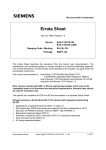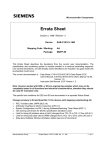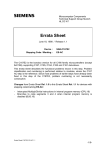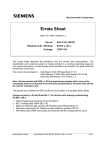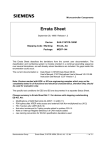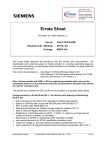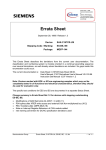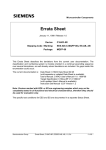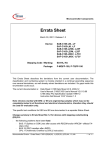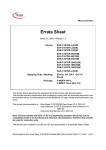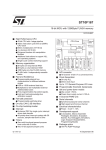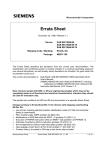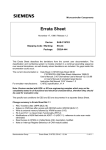Download Errata Sheet
Transcript
Microcontroller Components Errata Sheet November 3, 1998 / Release 1.0 Device: Stepping Code / Marking: Package: SAB-C163-LF SAB-C163-L25F SAF-C163-L25F AC TQFP-100 This Errata Sheet describes the deviations from the current user documentation. The classification and numbering system is module oriented in a continual ascending sequence over several derivatives, as well already solved deviations are included. So gaps inside this enumeration could occur. The current documentation is: Data Sheet: C163-L Data Sheet 1998-08 User’s Manual: C165/C163 User’s Manual V2.0 10.96 Instruction Set Manual 12.97 Version 1.2 Note: Devices marked with EES- or ES are engineering samples which may not be completely tested in all functional and electrical characteristics, therefore they should be used for evaluation only. The specific test conditions for EES and ES are documented in a separate Status Sheet. Change summary to Errata Sheet Rel.1.2 for devices with stepping code/marking AB: • • • • • Problem CPU.11 (Stack Underflow Trap during Restart of interrupted Multiply) fixed Problem RST.1 (System Configuration via P0L.0 during Software/Watchdog Timer Reset) fixed PEC Transfers after JMPR (BUS.18): note about TASKING software development tools added Read Access to XPERs in Visible Mode (X9): description modified Note on Pin OWE (Oscillator Watchdog Enable) added (see end of document) Semiconductor Group Errata Sheet, C163-L(25)F, AC, 1.0, Mh - 1 of 8 - Functional Problems: CPU.17: Arithmetic Overflow by DIVLU instruction For specific combinations of the values of the dividend (MDH, MDL) and divisor (Rn), the Overflow (V) flag in the PSW may not be set for unsigned divide operations, although an overflow occurred. E.g.: MDH F0F0 MDL Rn MDH MDL 0F0Fh : F0F0h = FFFF FFFFh, but no Overflow indicated! (result with 32-bit precision: 1 0000h) The same malfunction appears for the following combinations: n0n0 0n0n : n0n0 n00n 0nn0 : n00n n000 000n : n000 n0nn 0nnn : n0nn where n means any Hex Digit between 8 ... F i.e. all operand combinations where at least the most significant bit of the dividend (MDH) and the divisor (Rn) is set. In the cases where an overflow occurred after DIVLU, but the V flag is not set, the result in MDL is equal to FFFFh. Workaround: Skip execution of DIVLU in case an overflow would occur, and explicitly set V = 1. E.g.: CMP Rn, MDH JMPR cc_ugt, NoOverflow ; no overflow if Rn > MDH BSET V ; set V = 1 if overflow would occur JMPR cc_uc, NoDivide ; and skip DIVLU NoOverflow: DIVLU Rn NoDivide: ... ; next instruction, may evaluate correct V flag Note: - the KEIL C compiler, run time libraries and operating system RTX166 do not generate or use instruction sequences where the V flag in the PSW is tested after a DIVLU instruction. - with the TASKING C166 compiler, for the following intrinsic functions code is generated which uses the overflow flag for minimizing or maximizing the function result after a division with a DIVLU: _div_u32u16_u16() _div_s32u16_s16() _div_s32u16_s32() Consequently, an incorrect overflow flag (when clear instead of set) might affect the result of one of the above intrinsic functions but only in a situation where no correct result could be calculated anyway. These intrinsics first appeared in version 5.1r1 of the toolchain. Libraries: not affected Semiconductor Group Errata Sheet, C163-L(25)F, AC, 1.0, Mh - 2 of 8 - PWRDN.1: Execution of PWRDN Instruction while pin NMI# = high When instruction PWRDN is executed while pin NMI# is at a high level, power down mode should not be entered, and the PWRDN instruction should be ignored. However, under the conditions described below, the PWRDN instruction may not be ignored, and no further instructions are fetched from external memory, i.e. the CPU is in a quasi-idle state. This problem will only occur in the following situations: a) the instructions following the PWRDN instruction are located in external memory, and a multiplexed bus configuration with memory tristate waitstate (bit MTTCx = 0) is used, or b) the instruction preceding the PWRDN instruction writes to external memory or an XPeripheral (SSP module), and the instructions following the PWRDN instruction are located in external memory. In this case, the problem will occur for any bus configuration. Note: the on-chip peripherals are still working correctly, in particular the Watchdog Timer will reset the device upon an overflow. Interrupts and PEC transfers, however, can not be processed. In case NMI# is asserted low while the device is in this quasi-idle state, power down mode is entered. Workaround: Ensure that no instruction which writes to external memory or an XPeripheral precedes the PWRDN instruction, otherwise insert e.g. a NOP instruction in front of PWRDN. When a muliplexed bus with memory tristate waitstate is used, the PWRDN instruction should be executed out of internal RAM. BUS.18: PEC Transfers after JMPR instruction Problems may occur when a PEC transfer immediately follows a taken JMPR instruction when the following sequence of 4 conditions is met (labels refer to following examples): 1. in an instruction sequence which represents a loop, a jump instruction (Label_B) which is capable of loading the jump cache (JMPR, JMPA, JB/JNB/JBC/JNBS) is taken 2. the target of this jump instruction directly is a JMPR instruction (Label_C) which is also taken and whose target is at address A (Label_A) 3. a PEC transfer occurs immediately after this JMPR instruction (Label_C) 4. in the following program flow, the JMPR instruction (Label_C) is taken a second time, and no other JMPR, JMPA, JB/JNB/JBC/JNBS or instruction which has branched to a different code segment (JMPS/CALLS) or interrupt has been processed in the meantime (i.e. the condition for a jump cache hit for the JMPR instruction (Label_C) is true) In this case, when the JMPR instruction (Label_C) is taken for the second time (as described in condition 4 above), and the 2 words stored in the jump cache (word address A and A+2) have been processed, the word at address A+2 is erroneously fetched and executed instead of the word at address A+4. Note: the problem does not occur when the jump instruction (Label_C) is a JMPA instruction Semiconductor Group Errata Sheet, C163-L(25)F, AC, 1.0, Mh - 3 of 8 - Example1: Label_A: instruction x ; Begin of Loop instruction x+1 ..... Label_B: JMP Label_C ; JMP may be any of the following jump instructions: JMPR cc_zz, JMPA cc_zz, JB/JNB/JBC/JNBS ; jump must be taken in loop iteration n ; jump must not be taken in loop iteration n+1 ..... Label_C: JMPR cc_xx, Label_A ; End of Loop ; instruction must be JMPR (single word instruction) ; jump must be taken in loop iteration n and n+1 ; PEC transfer must occur in loop iteration n Example2: Label_A: instruction x ; Begin of Loop1 instruction x+1 ..... Label_C: JMPR cc_xx, Label_A ; End of Loop1, Begin of Loop2 ; instruction must be JMPR (single word instruction) ; jump not taken in loop iteration n-1, i.e. Loop2 is entered ; jump must be taken in loop iteration n and n+1 ; PEC transfer must occur in loop iteration n ..... Label_B: JMP Label_C ; End of Loop2 ; JMP may be any of the following jump instructions: JMPR cc_zz, JMPA cc_zz, JB/JNB/JBC/JNBS ; jump taken in loop iteration n-1 A code sequence with the basic structure of Example1 was generated e.g. by a compiler for comparison of double words (long variables). Workarounds: 1. use a JMPA instruction instead of a JMPR instruction when this instruction can be the direct target of a preceding JMPR, JMPA, JB/JNB/JBC/JNBS instruction, or 2. insert another instruction (e.g. NOP) as branch target when a JMPR instruction would be the direct target of a preceding JMPR, JMPA, JB/JNB/JBC/JNBS instruction, or 3. change the loop structure such that instead of jumping from Label_B to Label_C and then to Label_A, the jump from Label_B directly goes to Label_A. Notes on compilers: In the Hightec compiler beginning with version Gcc 2.7.2.1 for SAB C16x – V3.1 Rel. 1.1, patchlevel 5, a switch –m bus18 is implemented as workaround for this problem. In addition, optimization has to be set at least to level 1 with –u1. The Keil C compiler and run time libraries do not generate or use instruction sequences where a JMPR instruction can be the target of another jump instruction, i.e. the conditions for this problem do not occur. In the TASKING C166 Software Development Tools, the code sequence related to problem BUS.18 can be generated in Assembly. The problem can also be reproduced in C-language by using a particular sequence of GOTOs. With V6.0r3, TASKING tested all the Libraries, C-startup code and the extensive set of internal testsuite sources and the BUS.18 related code sequence appeared to be NOT GENERATED. Semiconductor Group Errata Sheet, C163-L(25)F, AC, 1.0, Mh - 4 of 8 - To prevent introduction of this erroneous code sequence, the TASKING Assembler V6.0r3 has been extended with the CHECKBUS18 control which generates a WARNING in the case the described code sequence appears. When called from within EDE, the Assembler control CHECKBUS18 is automatically ’activated’. X9: Read Access to XPERs in Visible Mode The data of a read access to an XBUS-Peripheral (SSP) in Visible Mode is not driven to the external bus. PORT0 is tristated during such read accesses. Note that in Visible Mode PORT1 will drive the address for an access to an XBUS-Peripheral, even when only a multiplexed external bus is enabled. X12: P0H spikes after XPER write access and external 8-bit Non-multiplexed bus When an external 8-bit non-multiplexed bus mode is selected and P0H is used for general purpose I/O, and an internal (byte or word) write access to an XBUS peripheral (SSP module) is performed, and an external bus cycle is directly following the internal XBUS write cycle, then P0H is actively driven with the write data for approx. 7ns (spikes on P0H). The spikes also occur if P0H is configured as input. However, read operations from P0H are not affected and will always return the correct logical state. The spikes have the following position and shape in a typical application: spikes occur after the rising edge of CLKOUT which follows the rising edge of ALE for the external bus cycle P0H.x = low --> output low voltage rises to approx. 2.5V, spike width approx. 7ns (@ 0.2 Vcc) P0H.x = high --> output high voltage drops to approx. 2.0V, spike width approx. 7ns (@ 0.8 Vcc) Referring to a worst case simulation the maximum width of the spikes may be 15ns with full amplitude (Vcc/Vss). But this might not be seen on application level. Note that if any of the other bus modes is selected in addition to the 8-bit non-multiplexed mode, P0H can not be used for I/O per default. Workaround: - use a different port instead of P0H for I/O when (only) an external 8-bit non-multiplexed bus mode is selected or use a different bus type (e.g. 8-bit multiplexed, where P1H may be used for I/O instead of P0H) or the spikes on P0H may be filtered with an application specific RC element, or do not perform an external bus access directly after an XBUS write access: this may be achieved by an instruction sequence which is executed in internal RAM e.g. ATOMIC #3 ; to prevent PEC transfers which may access external memory instruction which writes to XBUS peripheral NOP NOP Semiconductor Group Errata Sheet, C163-L(25)F, AC, 1.0, Mh - 5 of 8 - Deviations from Electrical- and Timing Specification: The following table lists the deviations of the DC/AC characteristics from the specification in the C163-L Data Sheet 1998-08. Problem Parameter short name Symbol Max. CPU Clock = 25 MHz min. max. Variable CPU Clock Unit 1/2TCL = 1 to 25 MHz min. max. AC.t13.2 RD#/WR# low time (no RW-delay) t13 45+tc instead of 50+tc 3TCL-15+tc instead of 3TCL –10+tc ns AC.t22.2 Data valid to WR# t22 18+tc instead of 20+tc 2TCL-22+tc instead of 2TCL-20+tc - ns AC.t34.1 CLKOUT rising edge t34 to ALE falling edge 0+ta 12+ta instead of 10+ta ns AC.t38.3 ALE falling edge to CS# t38 -6-ta 4-ta -6-ta instead of instead of instead of -4-ta 10-ta -4-ta 4-ta instead of 10-ta ns AC.t42.1 ALE falling edge to RDCS#, WRCS# (with R/W Delay) t42 14+ta instead of 16+ta TCL-6+ta instead of TCL-4+ta - ns AC.t43.1 ALE falling edge to RDCS#, WRCS# (no R/W Delay) t43 -6+ta instead of -4+ta -6+ta - ns 22+tc instead of 26+tc 2TCL-18+tc instead of 2TCL-14+tc - ns AC.t50.1 Data valid to WRCS# t50 12+ta 0+ta instead of 10+ta instead of -4+ta Notes: 1) Pin READY# has an internal pull-up. This will be documented in the next revision of the Data Sheet. 2) Timing t28: Parameter description and test changed from 'Address hold after RD#/WR#' to 'Address hold after WR#'. It is guaranteed by design that read data are internally latched by the controller before the address changes. 3) During reset, the internal pull-ups on P6.[4:0] are active, independent whether the respective pins are used for CS# function after reset or not. Semiconductor Group Errata Sheet, C163-L(25)F, AC, 1.0, Mh - 6 of 8 - History List (since device step AA) Functional Problems Functional Short Description Problem Fixed in step CPU.11 Stack Underflow Trap during restart of interrupted Multiplication CPU.17 Arithmetic Overflow by DIVLU instruction BUS.18 PEC transfers after JMPR INT.8 Interrupt Generation during Cache Hit PWRDN.1 Execution of PWRDN Instruction while pin NMI# = high RST.1 System Configuration via P0L.0 during Software/Watchdog Timer Reset X9 Read Access to XPERs in Visible Mode X12 P0H spikes after XPER write access and external 8-bit Non-multiplexed bus AC AB AC AC/DC Deviations AC/DC Deviation Short Description AC.t13.2 RD#/WR# low time (no RW-delay) 3TCL-15ns AC.t22.2 Data valid to WR# 2TCL-22ns AC.t34.1 CLKOUT rising edge to ALE falling edge 12+ta ns AC.t38.3 ALE falling edge to CS# -6/+4ns AC.t42.1 ALE falling edge to RDCS#, WRCS# (with R/W Delay) TCL-6ns AC.t43.1 ALE falling edge to RDCS#, WRCS# (no R/W Delay) –6ns AC.t50.1 Data valid to WRCS# 2TCL-18ns Semiconductor Group Fixed in step Errata Sheet, C163-L(25)F, AC, 1.0, Mh - 7 of 8 - Note on pin OWE (Oscillator Watchdog Enable) During direct drive or prescaler operation the Oscillator Watchdog (OWD) may be used to monitor the clock signal generated by the on-chip oscillator (either with a crystal or via external clock drive). For this operation the OWD uses the PLL clock signal to supervise transitions on the oscillator clock. As the PLL does not generate the CPU clock signal, it is disconnected from the oscillator clock and delivers its base frequency. A low level on pin OWE disables the Oscillator Watchdog. In this case, also the PLL is disabled to reduce power consumption. An internal pull-up is implemented on pin OWE. For 3 V operation (reduced supply voltage range) pin OWE must always be low (i.e. OWD disabled) as the PLL cannot deliver an appropriate clock signal in this case. Only direct drive (P0H.[7:5] = 011 during reset) or prescaler operation (P0H.[7:5] = 001) is possible in this case. For 5 V operation (standard supply voltage range) pin OWE should only be pulled low (i.e. PLL disabled) when direct drive or prescaler operation is configured. For all other combinations the PLL is configured to generate the CPU clock signal and therefore should not be disabled by a low level on pin OWE. PLL configurations with OWE = low result either in direct drive operation (when P0H.7 = high) or prescaler operation (when P0H.7 = low). Previous steps of the C163-L (e.g. AB-step) in this case did not switch off the PLL, i.e. they would still multiply the clock supplied on XTAL1 to generate the internal CPU clock fcpu. Application Support Group, Munich Semiconductor Group Errata Sheet, C163-L(25)F, AC, 1.0, Mh - 8 of 8 -








